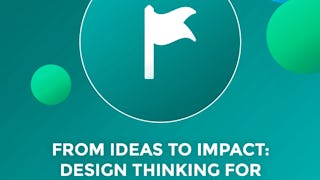Do you work for a nonprofit or in the social sector? Are you struggling to solve the problems and meet the needs of the people you serve? Come learn more about how design thinking, a human-centered approach to problem solving, can help you truly understand an issue, generate ideas worth testing and iterate to find solutions that make a real difference. Through global stories from areas as diverse as government, health care, and education, we’ll show you the tools, techniques and mindset needed to use design thinking to uncover new and creative solutions in the social sector.


Design Thinking for the Greater Good: Innovation in the Social Sector

Instructor: Jeanne M. Liedtka
46,465 already enrolled
Included with
(419 reviews)
Recommended experience
What you'll learn
What design thinking is and when to use it
How to prepare to see and take action when opportunity arises
How to use design thinking to generate innovative ideas
How to take the many ideas you generate and determine which ones are likely to produce specific, desired outcomes
Skills you'll gain
- Problem Solving
- Prototyping
- Data Visualization
- Innovation
- Ideation
- Creativity
- Brainstorming
- Process Mapping
- Service Design
- Storytelling
- Stakeholder Engagement
- Social Impact
- Design Thinking
- Human Centered Design
- Complex Problem Solving
- Design Research
- Qualitative Research
- User Experience
- Customer experience improvement
Details to know

Add to your LinkedIn profile
See how employees at top companies are mastering in-demand skills

There are 4 modules in this course
Welcome to the first week of Design Thinking in the Social Sector! This week, we provide an overview of design thinking: what it is, why it is different, and why we need it in these uncertain times, especially in complex organizations. We’ll examine the four simple questions at the heart of the design thinking methodology, and illustrate that approach with a visit to the Kingwood Institute in the UK. We’ll conclude this module by giving you a chance to hear from some other experts – Angela Meyer on the visualization tool and Dan Pink on six abilities that matter most.
What's included
13 videos1 reading1 assignment
Welcome back! This week, we’ll examine the types of problems that are well-suited for design thinking. We'll recognize what we need to do before we begin a project, and then take a deep dive into the first question in the design thinking process, “What is?” and the concepts of insights and design criteria. You’ll see how asking “What is?” helped improve daily living for adults with autism, their families, and the staff of the Kingwood Trust. Then we’ll look at the Monash University Medical Centre in Australia and how it asked this same question to make patient-centered care a reality. Along the way you’ll learn about two design tools: journey mapping and repertoire.
What's included
12 videos1 assignment
Welcome back! This week, we'll continue our exploration of repertoire and a "mindset for innovation" through two personas we call George and Geoffrey. We'll examine the question "What If?" as a way to think about possibilities. You'll look closely at how brainstorming within the design thinking process helped organizations as different as the Federal Drug Administration and the leaders of a small town of Iveragh, Ireland. This week's tools, storytelling and stakeholder mapping, illustrate ways to gather more information about projects and users.
What's included
11 videos1 assignment
Welcome to our final week! This week we transition from idea generation to testing by examining the intersection of what stakeholders want and what the organization can sustainably offer. We'll consider the role of prototypes as a way to test our assumptions about a solution, and consider what it takes to launch a solution into practice, and see real-life examples of prototyping and testing in social sectors as diverse as healthcare and agriculture. You'll begin to think about your own social sector challenge you could tackle with design thinking. We end this week with some advice and actions for impact.
What's included
14 videos5 readings1 assignment1 peer review
Instructor

Offered by
Explore more from Education
 Status: Free Trial
Status: Free TrialUniversity of Virginia
 Status: Free Trial
Status: Free TrialCoursera
 Status: Preview
Status: PreviewIE Business School
 Status: Free Trial
Status: Free TrialUniversity of Virginia
Why people choose Coursera for their career




Learner reviews
419 reviews
- 5 stars
72.14%
- 4 stars
23.09%
- 3 stars
3.33%
- 2 stars
1.19%
- 1 star
0.23%
Showing 3 of 419
Reviewed on Jan 11, 2021
I like how the topic is taught. I also like how it is presented. The materials - from the videos to the readings, they seem to be appropriate. I also like how it is paced.
Reviewed on Jun 5, 2020
It was good learning.It gave me perspective for my work. I probably doing something similar but had no clarity about different steps.
Reviewed on Mar 20, 2021
Great introduction to design thinking, with practical tips and tools. Well designed learning experience with a robust assessment process too

Open new doors with Coursera Plus
Unlimited access to 10,000+ world-class courses, hands-on projects, and job-ready certificate programs - all included in your subscription
Advance your career with an online degree
Earn a degree from world-class universities - 100% online
Join over 3,400 global companies that choose Coursera for Business
Upskill your employees to excel in the digital economy
Frequently asked questions
To access the course materials, assignments and to earn a Certificate, you will need to purchase the Certificate experience when you enroll in a course. You can try a Free Trial instead, or apply for Financial Aid. The course may offer 'Full Course, No Certificate' instead. This option lets you see all course materials, submit required assessments, and get a final grade. This also means that you will not be able to purchase a Certificate experience.
When you purchase a Certificate you get access to all course materials, including graded assignments. Upon completing the course, your electronic Certificate will be added to your Accomplishments page - from there, you can print your Certificate or add it to your LinkedIn profile.
Yes. In select learning programs, you can apply for financial aid or a scholarship if you can’t afford the enrollment fee. If fin aid or scholarship is available for your learning program selection, you’ll find a link to apply on the description page.
More questions
Financial aid available,
¹ Some assignments in this course are AI-graded. For these assignments, your data will be used in accordance with Coursera's Privacy Notice.

